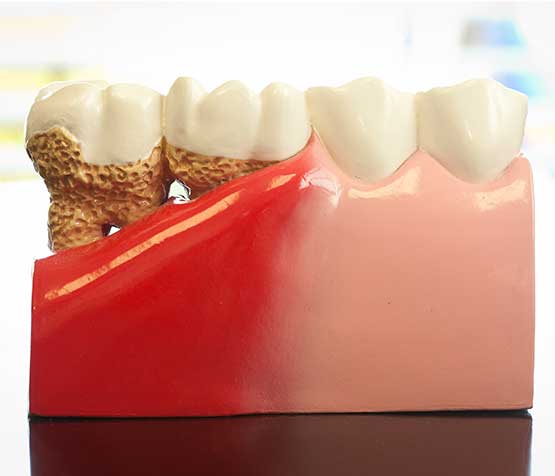A periodontist is a dentist who specializes in the prevention, diagnosis, and treatment of infections and diseases in the soft tissues surrounding the teeth and the jawbone to which the teeth are anchored. Periodontists have to train an additional three years beyond the four years of regular dental school. As such, they are familiar with the most advanced techniques necessary to treat periodontal disease and place dental implants. Periodontists also perform a vast range of cosmetic procedures to enhance the smile to its fullest extent. Many people are unsure of when to see a periodontist. Below, we explain when to see a periodontist and what we do to help our patients.

How Do I Know if I Need to See a Periodontist?
Periodontal disease begins when the toxins found in plaque start to attack the soft or gingival tissue surrounding the teeth. This bacterium embeds itself in the gum and rapidly breeds, causing a bacterial infection. As the infection progresses, it starts to burrow deeper into the tissue causing inflammation or irritation between the teeth and gums. The response of the body is to destroy the infected tissue, which is why the gums appear to recede. The resulting pockets between the teeth deepen – and if no treatment is sought, the tissue which makes up the jawbone also recedes, causing unstable teeth and potential tooth loss.
Referrals from General Dentists and Self-Referral
There are several ways treatment from a periodontist may be sought. In the course of a regular dental check-up, if the general dentist or hygienist finds symptoms of gingivitis or rapidly progressing periodontal disease, a consultation with a periodontist may be recommended. However, a referral is not necessary for a periodontal consultation.
If you experience any of these signs and symptoms, it is important that you schedule an appointment with a periodontist without delay:
- Bleeding While Eating or Brushing: Unexplained bleeding while consuming food or during the course of daily cleaning is one of the most common signs of periodontal infection.
- Bad Breath: Continued halitosis (bad breath) which persists even when a rigorous oral hygiene program is in place, can be indicative of periodontitis, gingivitis or the beginnings of an infection in the gum tissues.
- Loose Teeth and Gum Recession: Longer looking teeth can signal the recession of the gums and bone loss due to periodontal disease. As this disease progresses and attacks the jawbone (the anchor holding the teeth in place), the teeth may become loose or be lost altogether.
- Loose Teeth and Gum Recession: Longer looking teeth can signal the recession of the gums and bone loss due to periodontal disease. As this disease progresses and attacks the jawbone (the anchor holding the teeth in place), the teeth may become loose or be lost altogether.
- Related Health Conditions: Heart disease, diabetes, osteopenia, and osteoporosis are highly correlated with periodontitis and periodontal infections. The bacterial infection can spread through the bloodstream and affect other parts of the body.
Diagnosis and Treatment
Before initiating any dental treatment, the periodontist must extensively examine the gums, jawbone and general condition of the teeth. When gingivitis or periodontal disease is officially diagnosed, the periodontist has a number of surgical and non-surgical options available to treat the underlying infection, halt the recession of the soft tissue and restructure or replace teeth which may be missing.
- Gingivitis: When the gum pockets exceed 4mm in depth, the periodontist or hygienist may perform scaling and root planing to remove debris from the pockets and allow them to heal. Education and advice will be provided on an effective cleaning regime thereafter.
- Moderate Periodontal Disease: If the gum pockets reach 4-6mm in length a more extensive scaling and root planning cleaning might be required. This cleaning is usually performed under local anesthetic.
- Advanced Periodontal Disease: Gum pockets in excess of 6-7mm are usually accompanied by bone loss and gum recession. Scaling and root planning will always be performed as the initial non-surgical treatment. In addition to non-surgical treatments, the periodontist may recommend surgical treatment to reduce pocket depth.
- Tooth Loss: Where one or several teeth are missing due to periodontal disease, dental implants are an effective option. If the bone is strong enough to provide a suitable anchor for the prosthetic tooth, the implant can be placed. However, if the bone is severely eroded, bone grafts may have to be performed by the periodontist first in order to provide a suitable anchor for the new tooth/teeth.
As periodontists, we diagnose and treat the various types of periodontal disease. If you have been referred to see a periodontist or if you suspect you have gum disease, we invite you to contact us to schedule your appointment. At Peace Periodontics we are your partners in oral health.
To learn more about Periodontics and when to see a Periodontist, we invite you to contact Peace Periodontics to schedule a consultation appointment.
Featured Periodontal Services
Testimonial
Contact Us
Working Hours
| Monday: | 8:00 am – 5:00 pm |
| Tuesday: | 8:00 am – 5:00 pm |
| Wednesday: | 8:00 am – 5:00 pm |
| Thursday: | 8:00 am – 5:00 pm |
| Friday: | 8:00 am – 2:00 pm |
| Saturday’s, Sunday’s & Statutory Holidays: |
Closed |
